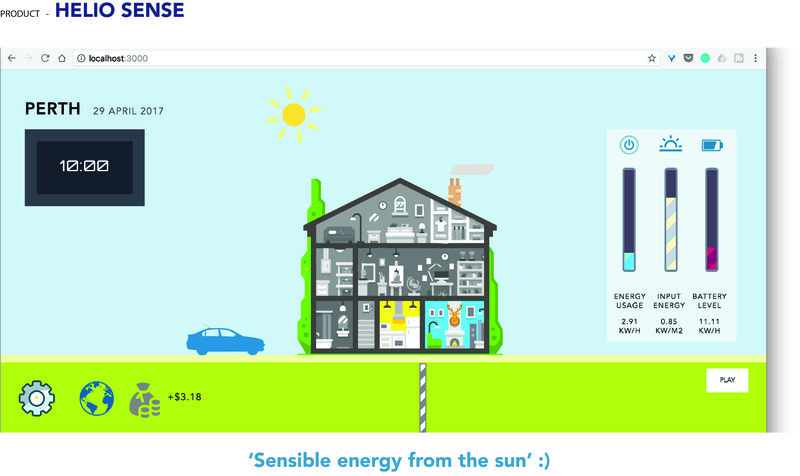Solar Rangers | You are my Sunshine
Awards & Nominations
Solar Rangers has received the following awards and nominations. Way to go!
The Challenge | You are my Sunshine
Helio Sense : A Brighter Future for Energy
Helio Sense is an engaging and smart app which monitors energy use and interacts with home appliances. The app aims to encourage efficient habits through gamification, minimize consumption peaks, and educate families on issues affecting energy production.

THE CHALLENGE:
Create a medium to help people understand energy output from a solar panel, and a tool to plan energy consumption based on expected energy output from solar technologies.
DEMO/PROTOTYPE:
Bit.ly/SolarRangers
Works best on desktop browser, if viewing on mobile you will need to request 'desktop site'.
You can click on the Settings (wheel-shaped) icon to bring up an Appliances Settings page, and also the Earth icon to bring up a social interactive element which allows you to compare energy usage with other home users of the system.
OVERVIEW:
We approached this challenge wondering from a home point of view. We tried to understand the energy use for a family on a typical day e.g. peak times of consumption, and ways in which we can encourage consumers to use less energy while maximizing their solar power available, ultimately minimizing power requirements from the utility provider.
OUR SOLUTION:
We used solar irradiance data from the NASA HI-SEAS Habitat project to model a day of solar power and included appliance usage based on typical power ratings of Australian appliances.
Included is also a preview of our gamification element which we hope will contribute to a shift in consumer behaviour towards more efficient use of energy, thereby saving money and reducing peak loads on the power grid.
We discovered that bits and pieces of a similar concept are working effectively in countries around the world (e.g. Hong Kong and Melbourne) and we intend on putting the pieces together to create a Smart Energy Home that people can interact with, where families are being rewarded for good energy saving habits. We also hope to incorporate elements of education for families on factors influencing power production and consumption.
CURRENT VS FUTURE FUNCTIONALITY:
Current Features (Simulated):
- Daily energy input/output shown via app animation following your location time. This would be obtained from internet connection details or configuring the system initially upon first use.
- Appliance Settings panel (via cog icon) to tell the system the power ratings of your home appliances in order to calculate appropriate energy use and costing information.
- A 'social' information panel (via earth icon) to compare your usage amongst local homes and around the world. Our app simply shows a representation of how this feature may look.
- An 'Energy Forecast' shown on the right-hand side of the simulation screen. This is not real data but would be implemented based on various data sources depending on your location. For example, in Perth, there is a collaboration between Murdoch University and Sustainable Energy Now (SEN) which uses various datasets predicting daily solar power output for the days ahead.
- Notifications from energy provider of upcoming system maintenance which may lead to temporary blackouts due to network upgrades or load shifting during expected peak times. Network faults could also be advised (based on internet connectivity, perhaps with a mobile data backup).
- System telemetry data reporting back to the energy provider on usage patterns and individual home appliance data, which could be used by manufacturers to improve design efficiency and software updates for IoT (Internet of Things) devices.
IMPACT:
One of the biggest challenges for energy providers is managaing peak periods of energy consumption and adjusting output accordingly. If we can contribute to more efficient energy habits with encouragement techniques such as gamification, then we could potentially reduce peak loads on power grids globally.
The two biggest hurdles are the individual energy usage of consumers and ways to motivate habitual change in energy consumption. We know that people love rewards and good competition, so that has been factored into our design. We hope this leads to smarter and more conscious energy use so that energy providers have more time to work on maintaining their reliability and upgrading systems, rather than catching up to meet user demands daily.
BEHIND THE APP:
- React for front-end and Python for data structuring
- Code is available at: https://github.com/sandra-arato/NASA-SpaceAppsChallenge
1. NASA's HI-SEAS Meteorological Data
https://www.dropbox.com/sh/g0gf1awqqaumyqt/AAB1G07...
2. Essential Energy - Appliances power
http://www.essentialenergy.com.au/asset/cms/PDF/Ap...
SpaceApps is a NASA incubator innovation program.